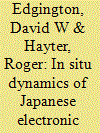| Srl | Item |
| 1 |
ID:
123042


|
|
|
|
|
| Publication |
2013.
|
| Summary/Abstract |
In September 1987, representatives of 24 countries met in Montreal and accomplished a rare feat in international politics: a successful environmental accord. The Montreal Protocol on Substances that Deplete the Ozone Layer, which UN Secretary-General Kofi Annan later called "perhaps the single most successful international agreement to date," set the ambitious goal of phasing out chlorofluorocarbons (CFCs) and other dangerous chemicals. It worked: by 1996, developed countries had stopped their production and consumption of CFCs, and by 2006, the 191 countries that had ratified the protocol had eliminated 95 percent of global ozone-depleting emissions.
|
|
|
|
|
|
|
|
|
|
|
|
|
|
|
|
| 2 |
ID:
119915


|
|
|
|
|
| Publication |
2013.
|
| Summary/Abstract |
This paper contributes to the theory of subsidiary evolution in multinational corporations through utilising a value chain approach. It assesses the changing activities of the branches of Japanese electronics firms located in Southeast Asia (the ASEAN region) since the 1997-1998 financial crisis. In the paper, we argue that a modest development of Japanese subsidiaries has occurred in this region during the past 10 years or so. We connect models of subsidiary development to Michael Porter's value chain in the results of a set of interviews with 37 managers in the factories, sales offices and regional headquarters of Japanese subsidiary companies located in Singapore, Malaysia and Thailand. We show that decentralisation of management functions from Japan occurred in both primary and support activities of the value chain. However, corporate long-term research and development did not disperse to Southeast Asia and is unlikely to in the near future. The article interprets these results and highlights the need for further research relating to the evolving geography of Japanese electronics multinational corporations and their subsidiaries in Southeast Asia.
|
|
|
|
|
|
|
|
|
|
|
|
|
|
|
|